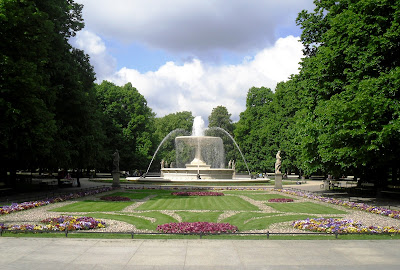...or, at best, like this:
Hotel Sofitel Warsaw Victoria was built in the mid-70's, offering "the highest level of service" at the time.
This was what I expected, along with stern, grey-faced people in outdated clothes and heavy boots. Sure, there were obviously a few buildings that lacked aesthetic quality, but what I mainly found was a busy, modern city full of beautiful young people, lush parks, and countless cafes (with really tasty coffee). Shame on me for being so prejudiced! My apologies—at least I know better now.
The city was more or less destroyed during World War II, but great effort has been put in to restore the old buildings, recreating what was lost. The scars are ever-present, however—holes from bullets and grenades can still be spotted all around, and by chance I happened to stumble (figuratively speaking) on remnants of the old Ghetto wall, marking the area where over 400,000 jews were confined by the Germans during the Nazi occupation.
A word that springs to mind: unfathomable. There is no better way to learn history than to walk in the footsteps of those who came before us, as spine-chilling as those paths may be.
Walking through the city, I often felt like I could as easily have been in Sweden. This stretch of Krakowskie Przedmieście might as well have been Avenyn in Gothenburg:
...whereas this part of Warsaw's Old Town felt just like its counterpart in Stockholm, with its winding alleys and colorful facades:
Some of the buildings surrounding Rynek Starego Miasta (Old Town Market Place) were still under renovation, while others were finished.
Parks were plentiful and incredibly lush, as exemplified by Ogród Saski (The Saxon Garden).
Naturally, I couldn't pass up the opportunity to make quick stop at the modest Maria Skłodowska-Curie Museum, situated across the street from the 18th-century apartment building where the twice Nobel laureate was born.
Marie and I!
Foodwise, I was surprised by the availability of vegetarian options, especially considering the brief research I had made pre-takeoff. Admittedly, the Polish pierogis didn't really do it for me, but their nalesniki (crepe-like pancakes) were right up my alley. Another discovery was that Warsawians seem to be crazy about ice cream. And we're not talking any ice cream—no, really weird-looking, phallic ice cream. The kind of ice cream you don't want to be seen eating in public.
I mean, really...?
That's it for Warsaw—next up is Amsterdam. In a day or two, that is... (I have a job, you know!)
















The ice cream was even advertised as being 'male' ! Really nice pictures, although I think I remember that the inscription on Marie's statue said it was Polonium
ReplyDeleteI think you're right about the radionuclide! Will update accordingly. (I guess the Poles are extra proud to showcase polonium, seeing as she named the element after her mother country.)
DeleteIndeed! Moreover, I believe the statue was a gift from the French (via Francois Hollande) as we are also proud and like to share the claim to Marie's heritage.
Delete(kan tydligen inte posta på rätt plats haha, försöker igen)
ReplyDeleteHehe, Sofitel. Du får döpa om ditt hem till Sofitel Fremont Helena Linnea.
Haha, givet! :) Här erbjuds också the highest level of service, som alla vet.
Delete